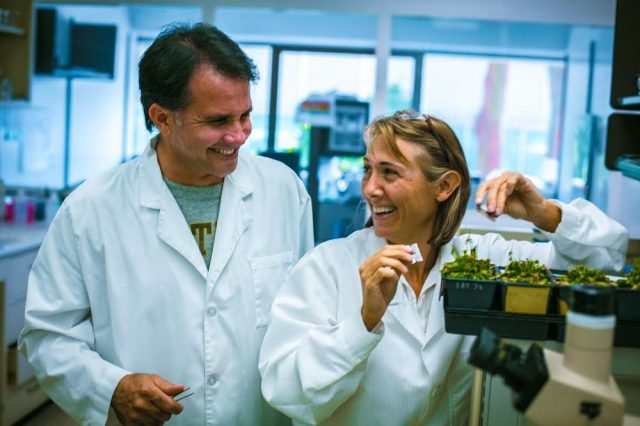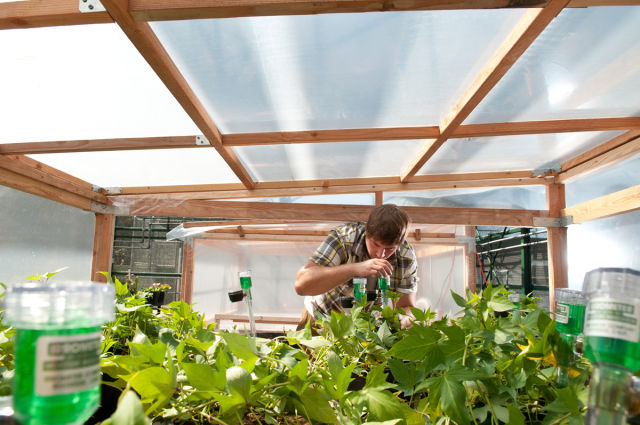
Hope Jahren's memoir about becoming a biogeoscientist—someone who studies the deep geological history of plant life on Earth—is the year's biggest surprise bestseller. Humbly titled Lab Girl, it's the story of how Jahren escaped a working class town to become a young scientist in the high-tech labs of UC Berkeley and Georgia Tech. It's also a fascinating introduction to the ways plants survive, even though they can never flee from danger. But most of all, it's a crazy adventure about two broke geeks, Jahren and her lab technician Bill Hagopian, who somehow scrape together enough cash and spare parts to build lab instruments unlike anything the scientific world had ever seen. You won't be able to put this book down, and that's a quality one rarely finds in a nonfiction book about science.
Radio Shack lab
Jahren and Hagopian met when she was a graduate student helping to run a class where he was an undergrad learning about field work. Out of all the students in the class, Hagopian's work was the most meticulous—but he also sprinkled his lab notes with weird jokes that only Jahren found amusing. They became fast friends, and when she got her first job as an assistant professor at Georgia Tech, she offered him a job as lab technician. Paying Hagopian a near-poverty-level salary took up most of her grant money from the National Science Foundation. So the two spent several years living on cheap pizza, Ensure, and candy bars, saving all their money to build up the Jahren Lab. Their goal is to simulate atmospheres from Earth's past and then grow plants inside those atmospheres to understand how life forms survive dramatic changes in the molecular composition of the air they breathe. This is obviously relevant to the current carbon loading in our atmosphere, but it also helps scientists understand what our planet was like hundreds of millions of years ago, when carbon and oxygen levels were quite different from those today.
In Lab Girl, Jahren describes her early years perfecting a technique to blow glass bubbles full of alien atmospheres, while Hagopian lives out of his van and designs sophisticated growth chambers. Without much money, the two are left scrounging up parts to use in their lab from the recycling bins of other labs—and from Radio Shack, of course. Speaking to Ars by phone from her current lab at the University of Hawaii, Jahren said, "When we can't get a controller from a catalogue, we go to Radio Shack. We love Radio Shack. Being able to jerry-rig things is super satisfying." Getting to scientific conferences to present their work was even more challenging. In one memorable scene, Jahren and Hagopian "borrow" the lab van from Georgia Tech and drive across the country to San Francisco for the annual meeting of the American Geophysical Union. They had so little money that all their meals for several days came from an icebox full of lunch meat. It all backfired when one of their graduate students crashed the van and the slightly rancid contents of the icebox flew everywhere. Still, Jahren managed to clean up and make it to San Francisco in time—only to be yelled at by one of her colleagues that her hypotheses are just plain wrong.

Two Fullbrights and several other prestigious awards later, Jahren is sanguine about the memory. But we can still feel her anger and how these setbacks only made her more committed, pushing her to prove that we can use carbon isotope analysis on plant fossils to reverse engineer previous atmospheres on Earth. There's a strong emotional, personal element to Lab Girl that reminds us how scientists feel just as passionately about their research as artists do about their creations.
Today, Jahren and Hagopian are just as DiY with their instrumentation as ever, though the Jahren Lab in Honolulu is funded at a much more comfortable level. Jahren told Ars that they still buy a lot of their equipment from Radio Shack and Home Depot and that they learn a lot about how to build their greenhouses from YouTube videos aimed at pot growers. "Our growth chambers are plexiglass boxes about as big as a bookshelf, and we can control the greenhouse gas levels, light, and humidity on the order of moment-to-moment fluctuations," she said. "It's not easy when you've got a living organism in there that's actively making feedback. They're in there at positive pressure, and the atmosphere turns over about every ten minutes or so." She laughed about going to grow shops where "we're the most innocent thing they've seen in days." But "they have good advice on making things grow inside," using everything from little pieces of tupperware to vaporizers. And the results are excellent. "We can put in the greenhouse gases or scrub them out," Jahren said proudly. "And we're the only lab that can do that to this degree."
Plant consciousness
One of the ways that Jahren interweaves her scientific story with her personal one is by including chapters about plant life cycles that provide a counterpoint to her own. When she's growing up, we learn how seeds function; when she has a baby, we learn about how plants reproduce. As a result, we're forced to see how dramatically different plants are from us—as well as the unexpected ways they exhibit signs of consciousness that's a distant echo to our own. Though scientists fear anthropomorphizing plants, making them seem inaccurately human-like, Jahren says she decided to break that rule "unapologetically." Without some anthropomorphizing, "you revert to scientific language and you're just talking to other scientists." Plus, she asked, "Where is the word that describes a plant doing something like remembering? A plant does call up data acquired in the past and invoke it in the present. Where is the word for that? There's this infuriating gap between human language and scientific language."

She added that plants may have some form of consciousness:
There's tons of scientific evidence that they take in information about the world and that their biologic activities are contingent upon that information in real time. Now isn’t that what our consciousness breaks down into really? So I think if you look up the words in the dictionary and you compare it to scientific evidence, by strict definition yes they do have consciousness. Do they do it the same way we do it? No. Do they have a brain, spinal cord, and sensory nerve endings? No, no, no. Science is in the baby stages of figuring out what they do have. What is it? The fact that we’re so enamored of that question is telling. At the heart of that is this age-old dilemma of how do you co-exist with something and exploit it at the same time. You do it by de-animating it; you say it’s a thing. But it’s not a thing. It’s alive. That ambiguity is never going to go away, even if I break all the rules and say things like plants “remember,” “know,” and “choose”. All those are words that we reserve for animated entities toward which we acknowledge an ethical responsibility. That’s why that question is so sticky.
Jahren suggests we always remember this "sticky" question, especially because we depend on plants for everything from building materials to fuel. She urges her readers to plant a tree and consider what balance we want to strike between "co-existing" and "exploiting" plants.
Working-class science
By the end of Lab Girl, we understand how important Jahren and Hagopian's work has been to biogeoscience—but we also follow the progress of their unusual friendship. At one point, Jahren wonders whether they are soulmates or siblings. Their nonsexual but intimate friendship defies categorization, and it provides a template for the kinds of relationships that men and women will ideally start forming more often as gender balance in the sciences evens out. But it isn't just their cross-gender friendship that Jahren wants to celebrate. Hagopian, she says, is like a lot of people who work in the sciences, "geniuses with instrumentation in tech, [but who] don't want to be professors and give talks." She hopes that these "true heroes" can be celebrated in a more public way and their contributions recognized as being key to scientific progress. "I needed a whole book to explain the heroism of someone unusual," she said.
Jahren also worries that we're "starving science to a breaking point." As she reveals in her book, there are many talented scientists who never get the opportunity to do science full time. Her hope is that we can use institutions like the National Science Foundation (NSF) to fund more basic research and that her book can show people what it’s really like to try doing science when there is almost no funding available. "You could double the funding of the NSF and still not be anywhere near wasting a nickel," she said. "Their funding requests are not lavish."
After reading Lab Girl, you're likely to look at the world of science in a whole new way. Yes, there's a kind of magic to it, especially when you're discovering what plant "consciousness" might be like and how the Earth's atmosphere has changed over time. But it's also a job, and a tough one, because there's less and less money to go around. Jahren may have escaped her working-class town, but as a scientist she'll never fully escape from the anxiety of poverty. She and Hagopian have built their lab and lives with the assumption that they are only one paycheck away from having to go back to that van full of cheap lunch meat. Their discoveries may be changing how we understand the world, but the world will have to change to keep those discoveries coming.
reader comments
47